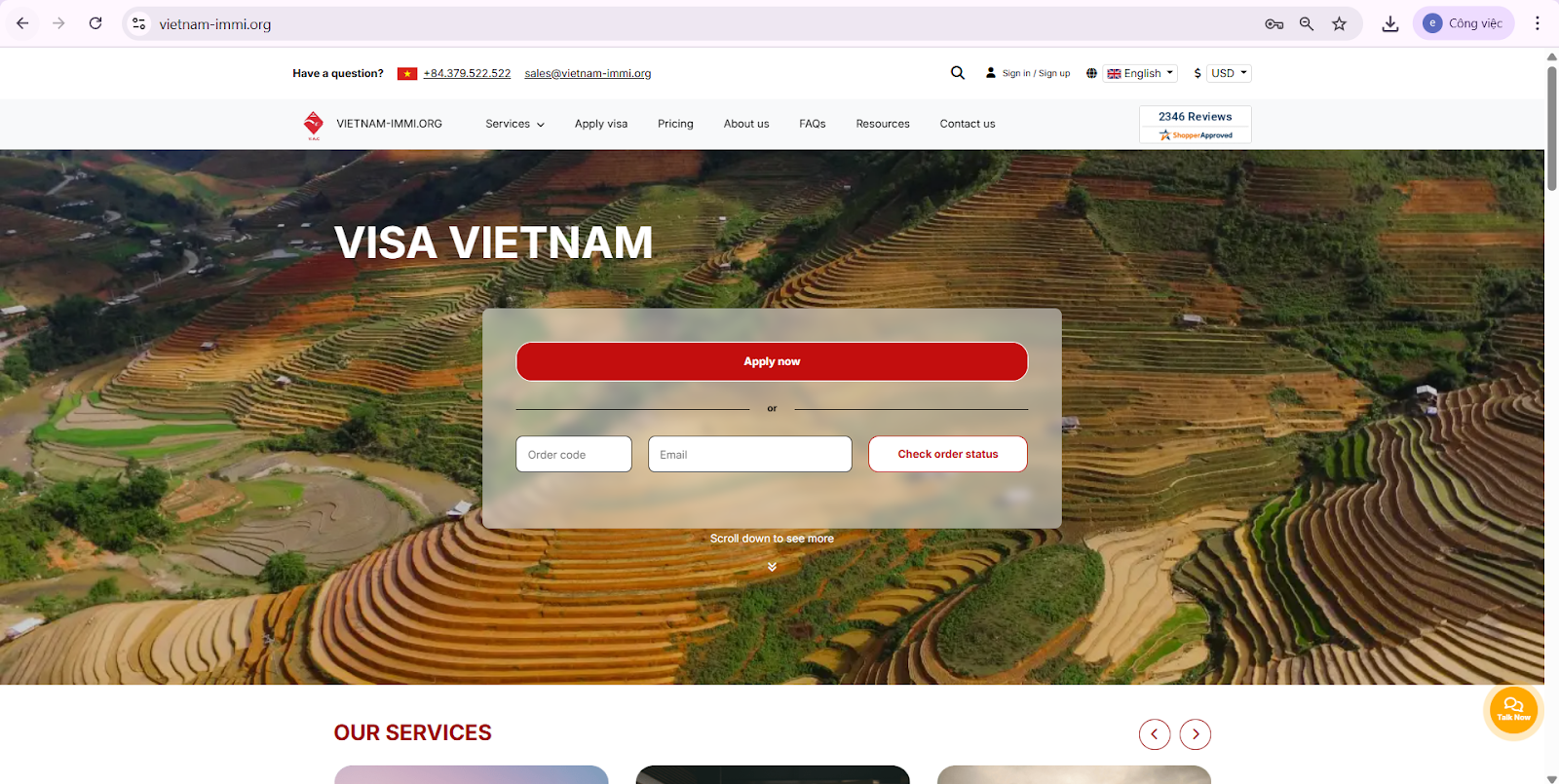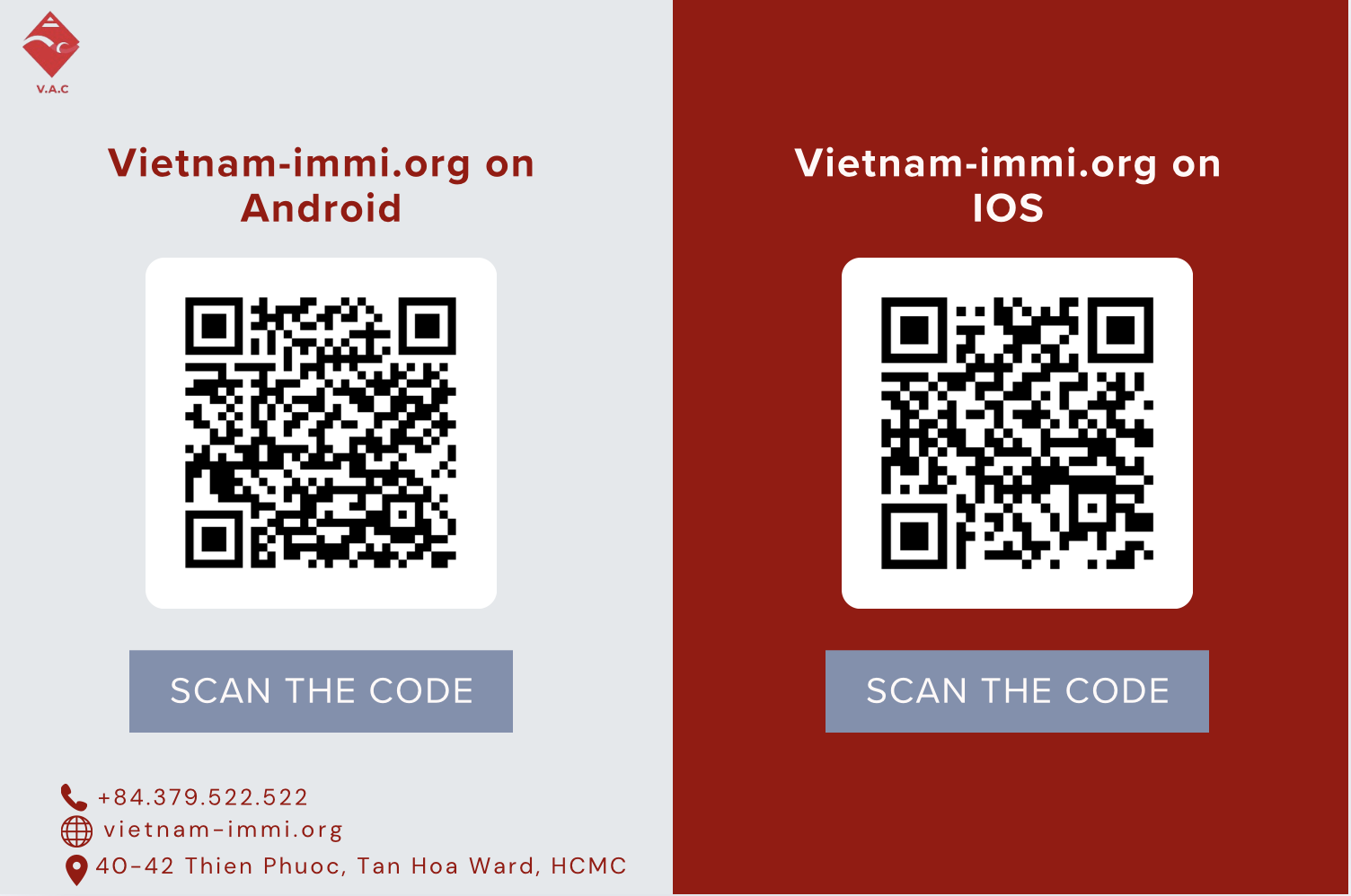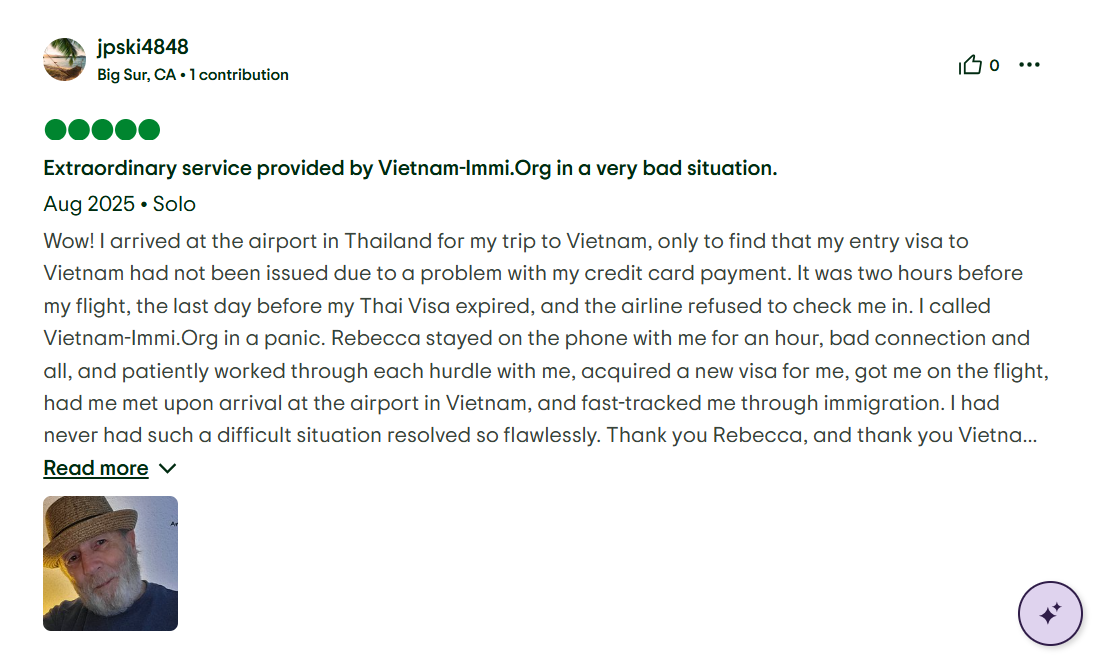
Last Update: Sunday November 02, 2025
Applying for a visa should not be complicated, especially when traveling for tourism, business, or family visits. Vietnam-immi.org provides a streamlined Vietnam visa service that supports travelers in obtaining both the Vietnam e-visa application and the Vietnam visa approval letter required for Visa on Arrival (VOA). With multiple contact options available, applicants can choose the most convenient method to complete their Vietnam visa online.
Below are four easy ways to apply for your Vietnam visa with Vietnam-immi.org:
The website is the simplest and fastest way to submit your Vietnam e-visa application or request a Vietnam visa approval letter. The step-by-step online form allows you to enter personal details, travel information, and upload necessary documents. Secure payment options help finalize your Vietnam visa online in minutes. Applicants receive confirmation via email and ongoing support throughout the process.

Pro tips: Read More about Step-By-Step Guide To Completing The Vietnam-Immi.org's Visa Service Form
For travelers who prefer quick assistance or have urgent questions, the live chat function on Vietnam-immi.org offers immediate help. Professional visa consultants provide guidance, check your information, and help you complete the Vietnam e-visa application correctly. This option is ideal if you need real-time support or advice before submission.

Applying for a Vietnam Visa is now easier than ever. With Vietnam-immi.org, you can choose from four quick and secure methods — including online E-Visa application, visa approval letter, or our convenient mobile app. Enjoy a smooth, trusted process with expert support every step of the way.

A phone call gives applicants direct access to experienced visa advisors who can explain the process clearly and offer solutions for unique travel plans. This method is suitable for first-time visitors or those who require urgent processing of a Vietnam visa approval letter for last-minute travel.

Photo: Collected
Why Choose Vietnam-immi.org
Vietnam-immi.org is committed to providing a safe, reliable, and efficient Vietnam visa service with responsive customer care. Whether you need a Vietnam e-visa application or an urgent Vietnam visa approval letter, all four support channels ensure that your request is handled professionally from start to finish.
Whether you need a fast visa, airport fast track, private car, or eSIM, Vietnam-Immi.org is here 24/7 to support your trip.
Whatsapp: +84379522522
Hotline: +84.379.522.522
Email: sales@vietnam-immi.org

Last update: Monday October 27, 2025
Forget paperwork, long queues, and last-minute stress. With the Vietnam-immi.org app, you hold the power of a local travel concierge in your pocket—helping you glide through immigration, secure your car pickup, and stay connected with an eSIM, all with a few taps.
The Vietnam-immi.org app bundles all your entry, travel, and support needs into a single, sleek, intuitive interface. Whether you’re flying in for business, visiting family, or exploring Vietnam, everything you need is just a few taps away:

Visa Services — Apply for e-Visas or Visa on Arrival (VOA) without the usual paperwork fuss. Skip confusing procedures, fill in one form, submit, and track.
Fast-Track Airport Assistance — Breeze past immigration or long arrival queues with priority access and supervision.
Car Pick-Up / Drop-Off — Pre-book your ride so you’re not scrambling after landing. The driver meets you, you’re off. No waiting.
Stay Connected via eSIM — Avoid hunting for a local SIM. Turn on your phone, activate your eSIM, stay online right away. Ideal for booking transport, checking maps, or sharing your journey instantly.
Consular Services — Need translations, passports, legalization, or help with long-term visa exemption? The app handles that too.
Travelers praise the Vietnam-immi.org App for its ease of use and reliable support. Many describe it as “very easy to use” and “convenient”, with quick assistance whenever needed. Others highlight how helpful it is for tourists, making the visa process and travel arrangements smooth and stress-free.

1. Download & Sign Up
Available on both iOS (App Store) and Android (Google Play). Install, register with your email & phone.
➡ You can download easily here with just a click:
Download on Android
Download on IOS
2. Choose Your Services
Whether you need a visa, car pickup, fast-track, eSIM, or consular help (or some combination), select what you need. The UI guides you.
3. Fill Out the Relevant Forms
The app walks you through information required for each service (passport details, travel dates, etc.). It validates entries so you get fewer surprises.
4. Make Payment Securely
All payments are handled in-app with secure options. Clear fees are shown before you commit.
5. Track & Receive
See your visa application status, get notifications, confirm car pickup/driver details, activate your eSIM—every step is tracked so you’re informed.
6. Arrive & Enjoy
With everything pre-arranged, your arrival in Vietnam becomes more welcoming: minimal waiting, fewer hassles, more time enjoying the moment.
First-time visitors who are unfamiliar with Vietnam’s immigration and airport norms.
Business travelers who need fast and reliable entry and transport services.
Tourists who care about maximizing time, minimizing stress.
Anyone who prefers everything digital, pre-arranged, and well-organized.
With the Vietnam-immi.org app, you gain more than a set of services—you get peace of mind. Because traveling should be about discovery, not dead time in lines or lost in bureaucracy. Let the app handle logistics so you can focus on what matters: the journey.
Contact us and let us know your travel plans! Whether you’re coming for leisure or business, our team is here to support you with the latest Vietnam visa updates, urgent visas, and Fast Track airport services.

Last update: Monday October 22, 2025
Planning your first trip to Vietnam?
Whether you’re dreaming of the limestone cliffs of Ha Long Bay, the lantern-lit streets of Hoi An, or the vibrant bustle of Ho Chi Minh City, preparation is key to making your experience smooth and unforgettable.
This essential pre-arrival checklist for Vietnam covers everything you need to know before you go—from visas and vaccinations to packing tips and cultural etiquette.
Quick Summary: Vietnam Travel Essentials at a Glance
Before you dive into the details, here’s a snapshot of what you’ll need to prepare:
Visa and travel documents
Money and payment options
Health and safety essentials
Packing must-haves for Vietnam’s climate
Cultural awareness and basic Vietnamese phrases
Foreigners who enter Vietnam should check if your nationality requires a visa to enter Vietnam. Many travelers can enter visa-free for short stays ranging from 14 to 45 days, while others need an eVisa or a Visa On Arrival (both need you to apply online first). You can proactively check online whether your nationality requires a visa to enter Vietnam, or contact us for personalized advice through:
Hotline: +84.379.522.522
Email: sales@vietnam-immi.org
For your passport, you need to have it valid for at least six months and ensure your passport has a minimum of two (2) blank pages for visa stamps and entry/exit marks. Make sure to keep both printed and digital copies of your essential travel documents—including your passport, visa, and travel insurance—so you’ll be well-prepared in case of any loss or unexpected situation during your trip to Vietnam.
2. Health and Safety Preparations
Before traveling to Vietnam, it’s a good idea to prepare any allergy medications or personal medicines according to your health needs. Make sure to bring enough for your entire trip, keep them in their original packaging, and carry a copy of your prescription in case you need a refill or medical assistance during your stay.
Don’t forget to purchase comprehensive travel insurance that covers medical emergencies, trip cancellations, and lost luggage—while Vietnam’s healthcare system continues to improve, treatment at private hospitals can be costly without proper insurance coverage.

Photo: Collected
3. Money and Budget Planning
Vietnam’s official currency is the Vietnamese Dong (VND). While credit cards are increasingly accepted in major cities, cash remains the most common form of payment, especially in smaller towns, street markets, and local eateries. ATMs are widely available across the country and usually accept international debit and credit cards.
It’s a good idea to carry some small bills for everyday purchases like taxis, food stalls, and local shops. In terms of costs, Vietnam is generally an affordable destination—budget travelers can expect to spend around $25–$40 per day, mid-range travelers around $50–$100, and luxury travelers about $150 or more depending on comfort and activity choices.
4. What to Pack for Vietnam Trip
Clothing:
Lightweight, breathable clothes for the warm southern regions.
A light jacket or sweater for the cooler northern areas and mountain destinations like Sapa.
Comfortable walking shoes for exploring cities and nature spots.
A raincoat or poncho for unexpected tropical showers.
Swimwear for beach destinations.
Modest outfits for visiting temples and religious sites.
Travel Essentials:
A universal power adapter and portable charger to keep your devices powered.
A reusable water bottle to stay hydrated and reduce plastic waste.
Toiletries & Health Items:
Sunscreen and insect repellent for outdoor protection.
Hand sanitizer and basic toiletries.
A small first-aid kit with essential medicines for minor needs.
With these items, you’ll be well-prepared and comfortable throughout your journey across Vietnam’s diverse regions.

Photo: Collected
5. Learn the Basics and Stay Connected in Vietnam
Language & Etiquette
While English is widely spoken in tourist destinations, learning a few Vietnamese words shows respect and helps you connect with locals:
Hello – Xin chào
Thank you – Cảm ơn
How much? – Bao nhiêu tiền?
Delicious – Ngon quá
When exploring temples or local homes, remember to dress modestly, remove your shoes before entering, and avoid touching people’s heads or pointing your feet at others. Staying calm, patient, and polite is highly valued in Vietnamese culture and will leave a positive impression wherever you go.
Connectivity & Communication
Vietnam offers strong 4G coverage and widespread Wi-Fi access in hotels, cafés, and restaurants. You can stay connected easily by:
Buying a local SIM card from Viettel, Mobifone, or Vinaphone (available at airports and convenience stores).
Using an eSIM, if your phone supports it, for instant connectivity.
Downloading useful apps such as Grab (transport), Google Maps (navigation)
Getting Around Vietnam
Transportation in Vietnam is convenient and affordable with:
Domestic flights connect major cities quickly and efficiently.
Trains offer scenic routes—especially between Hanoi and Da Nang.
In cities, Grab and taxis are the easiest ways to get around.
If you plan to rent a motorbike, make sure you have an international driving permit and always wear a helmet for safety.
With a few Vietnamese phrases, proper etiquette, reliable connectivity, and easy transportation options, you’ll be fully prepared to explore Vietnam confidently and comfortably.
6. Frequently Asked Questions
What’s the best time to visit Vietnam?
The best time to travel is from October to April when the weather is cooler and drier across most regions.
Can I drink tap water in Vietnam?
It's not recommended to drink tap water in Vietnam. As a precaution, drink bottled or filtered water. Most hotels provide complimentary bottled water daily.
Is Vietnam safe for solo travelers?
Yes. Vietnam is one of Southeast Asia’s safest destinations. Just use common sense—avoid showing valuables and be careful with street motorbike offers.
Whether you need a fast visa, airport fast track, private car, or eSIM, Vietnam-Immi.org is here 24/7 to support your trip.
Whatsapp: +84379522522
Hotline: +84.379.522.522
Email: sales@vietnam-immi.org

At Vietnam-immi.org, we are proud to be one of the most reliable and trusted names in online Vietnam visa services. Our platform is designed to provide secure, fast, and hassle-free visa solutions for travelers around the globe.

While you can apply directly via the Vietnam government portal, many travelers choose Vietnam-immi.org for the professional support, personal attention, and peace of mind we provide. Our services are tailored for travelers who value time, accuracy, and expert
Every application is reviewed by our visa specialists to ensure accuracy and completeness. This significantly reduces the risk of rejection due to errors or missing information.
We manage your entire visa process — from form submission to communication with immigration authorities. No paperwork hassles or confusing instructions.
Our dedicated support team is available around the clock, ready to assist you via email, whatsapp chat, or phone — even on weekends and holidays.

Thanks to our deep experience with Vietnam’s immigration system, we know how to navigate complex requirements — helping to improve your visa approval chances.
Need your visa urgently? We offer fast-track processing to meet tight travel deadlines.
We’ve assisted thousands of international travelers, including:
First-time visitors and frequent travelers
Business professionals on tight schedules
Families and group tourists
Digital nomads and long-term visitors
Travel agencies and corporate partners
Whether it’s a single-entry tourist visa or a detailed business visa application, we provide expert, personalized support every step of the way.
We’re committed to making your visa experience as smooth and stress-free as possible. Here’s what sets us apart:
A secure, easy-to-use online application system
Step-by-step support from experienced visa agents
Transparent pricing with no hidden fees
Fast, responsive customer service
A high success rate backed by positive client reviews
The review on TripAdvisor from the beloved customer
Applying with us is simple and straightforward:
Choose your visa type and complete our short online form
Upload your documents securely through our encrypted platform
Our experts review and process your application with care
Receive your visa digitally or get clear instructions for pickup
We handle the complex details — so you can focus on enjoying your trip.
Start Your Vietnam Visa Journey with Confidence
At Vietnam-immi.org, we blend local visa expertise with international service standards to deliver a seamless experience. As a trusted Vietnam Visa Services Center, we are committed to helping you travel confidently and securely.
Whether you're planning a business trip or a vacation, choose the visa experts trusted by thousands of travelers worldwide.
Whether you need a fast visa, airport fast track, private car, or eSIM, Vietnam-Immi.org is here 24/7 to support your trip.
Whatsapp: +84379522522
Hotline: +84.379.522.522
Email: sales@vietnam-immi.org